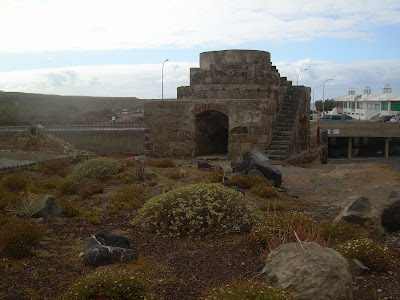(Es)
Esta vez nos mudamos hasta el municipio de #LosSilos, #Tenerife para hablar del Horno de Cal.
Exactamente, son dos hornos destinados en épocas pasadas a la fabricación de cal para uso agrícola y como material de construcción y que pudieron haber funcionado hasta los años 70, época en la que se generalizó el uso del cemento.
Recordar que las antiguas casas #canarias estaban hechas de/ o eran fabricadas con: piedras, barro, cal y madera
El más antiguo de estos hornos data del siglo XIX (según fuentes orales), el otro lleva impresa la fecha de 1931.
Su edificación es sencilla, compuesta de piedra y ladrillo en su mayor parte. Cuenta con sus respectivas bocas en la parte superior por donde salía el humo de las fogatas que provenían de la cocción de las piedras de cal en su interior.
Al lado de ellos queda en pie los restos del almacén de la fábrica así como un pequeño estanque rectangular de agua, fundamental para la elaboración del producto final.
La materia prima se transportaba en barcos de vela o de vapor desde Gran Tarajal, #Fuerteventura, era descargada en botes por el muelle de La Burrera o por el de Daute, según el estado de la mar, incluso muchas veces por el muelle de #Garachico.
Horno de Cal
(En)
They are two kilns destined in past times to the manufacture of lime for agricultural use and as a construction material and that could have worked until the 70s, time in which the use of cement was generalized.
Remember that the old #canarian houses were made of/ or were made with: stones, mud, lime and wood
The oldest one dates from the 19th century (according to oral sources), the other one for the 1931.
Its construction is simple, composed of stone and brick for the most part. It has their respective mouths at the top where the smoke from the bonfires that came from the firing of limestone came out.
Next to them stands the remains of the factory warehouse as well as a small rectangular water pond, essential for the production of the final product.
The raw material was transported in sailing or steam boats from Gran Tarajal, #Fuerteventura, was unloaded in boats by the dock of La Burrera or by the one of Daute, even many times by the dock of Garachico.


No hay comentarios:
Publicar un comentario